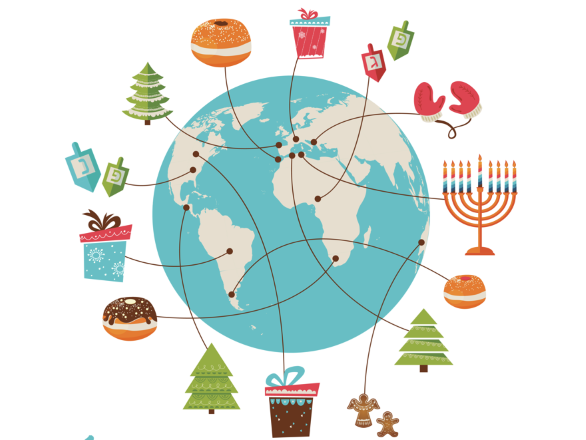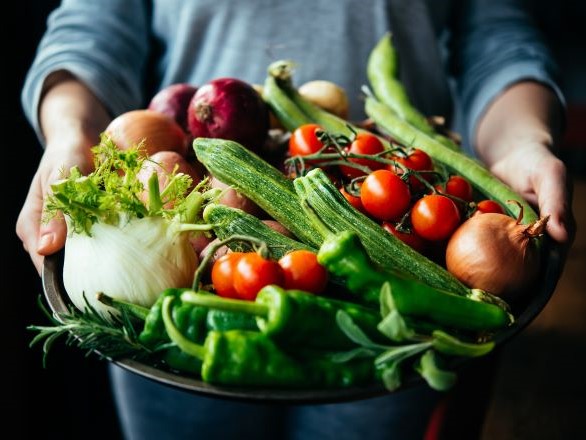In this edition
- Food Customs and the Holidays
- Healthy Starts at Home
- Holiday Roasted Butternut Squash
About the Newsletter
All the holidays have certain things in common, including unity, celebration and sharing. Learn about different food customs and the holidays that accompany them. This newsletter encourages better eating habits and includes a delicious recipe that you can try this holiday season.
Food Customs and the Holidays
by Natalie Mazzullo, M.Ed.
Natalie Mazzullo is the healthy aging coordinator for the Southern Area Extension at the University of Nevada, Reno, College of Agriculture, Biotechnology & Natural Resources.

Illustration of the world with various icons of holiday traditions.
The holidays are often a time to remember childhood memories and traditions. It may be putting up decorations, visiting with family or preparing a favorite holiday dish. All the holidays have certain things in common, including unity, celebration and sharing. They are celebrated with a feast and family members and loved ones are invited to join the festivities. The major differences include how each holiday is celebrated and the reason it is celebrated. While Christmas includes exchanging presents, Hanukkah and Kwanzaa are not traditionally associated with gift giving. The Winter Solstice is celebrated with a gathering and seasonal harvest. Below you will find the food customs typically prepared and eaten for each holiday.
Christmas
A traditional Christmas dinner main dish often consists of prime rib, baked ham, or roast turkey. This main dish is served with a side dish of scalloped potatoes, green bean casserole, and/or cranberry sauce. Celebrations can begin on Christmas eve or after the arrival of Santa on Christmas morning. Stockings often are filled with oranges, nuts and a few pieces of chocolate or coal if you were naughty.
Hanukkah
Latkes are a traditional favorite during Hanukkah. A latke is a potato pancake. Usually fried in oil. The latke is extremely versatile, and it can take on different flavors, textures, and seasonings. It is typically served with applesauce and sour cream. Another Hanukkah favorite is jelly donuts known as sufganiyah and chocolate coins or gelt given out to children.
Kwanza
The two most significant foods served during Kwanza are black-eyed peas and collard greens. They symbolize good luck and good fortune. Kwanza is known for its integration of African creole and jerk seasonings in its holiday recipes. You will likely find main dishes like catfish or jerk chicken on the table. Side dishes include like slaw, grits, beans, okra and rice.
Winter Solstice
From Ancient Romans to Indigenous Americans, cultures around the world have long held feasts and celebrated holidays around the Winter Solstice. In the United States, informal Winter Solstice gatherings often include a feast. Although there is no particular menu for Winter Solstice, the focus is often on fall harvest foods such as berries, nuts, squash, potatoes and wild game.
Ideas of Tasty, Affordable Holiday Menus
Healthy Starts at Home

A variety of vegetables on a platter.
Key Messages
- Choose foods with healthy fats and limit foods with unhealthy fats.
- Make small changes to your fast-food or convenience-food favorites to improve your health.
- Try making your own snacks at home.
- Eat a variety of colorful fruits and vegetables
Challenge Yourself
- Try a new recipe – experiment with ingredients.
- Choose drinks with less added sugar – or make your own.
- Adjust a favorite recipe to use healthier fats or reduce unhealthy fats.
- Watch your portion sizes.
To find a class in your community email Elizabeth Mapula
Holiday Roasted Butternut Squash

Roasted butternut squash with walnuts and cranberries on a plate.
Butternut squash has a taste similar to sweet potato and can be used as a substitute in recipes using sweet potato. The recipe below is from Cooking Matters.
Ingredients
- 2 pounds butternut squash (approximately 3 cups)
- ¼ cup walnuts
- 2 tablespoons canola oil
- 1 teaspoon dried sage
- ¼ teaspoon salt
- ¼ teaspoon ground black pepper
- 1 tablespoon butter or canola oil
- ¼ cup dried cranberries
- 1 ½ tablespoons maple syrup
Instructions
- Preheat oven to 375°F.
- Rinse and peel squash. Cut off ends and discard. Cut squash at the neck, creating a narrow end and a round end. Cut round end in half and scoop out seeds with a spoon. Cut both ends into ¾-inch, even-sized cubes.
- Coarsely chop walnuts. Set aside.
- In a large bowl, add squash. Toss with oil, sage, salt and ground black pepper.
- Spread squash evenly on a baking sheet. Roast, stirring once, until tender, about 35-minutes.
- In a small skillet over medium heat, melt butter or heat oil. Remove from heat. Stir in cranberries and maple syrup.
- Gently toss cooked squash with cranberry mixture.
Chef's Notes
- To make flavors pop even more, stir in 1 tablespoon cider vinegar along with the cranberry mixture.
- You can use fresh sage instead of dried. Leave out dried sage in step 4. Roll four fresh sage leaves into a log shape and thinly slice. Cook fresh sage in butter or oil along with the walnuts in step 6.
- Use pecans or hazelnuts in place of walnuts. Try using raisins or dried cherries for the cranberries.
Tip: If you have any extra butternut squash, chop and add to soup or chili.
For more recipes by cooking matters
Published by:
Mazzullo, N., 2022, Healthy Living while Aging! (2022-12), Extension | University of Nevada, Reno
An EEO/AA Institution. Copyright ©
2025, University of Nevada Cooperative Extension.
A partnership of Nevada counties; University of Nevada, Reno; and the U.S. Department of Agriculture


